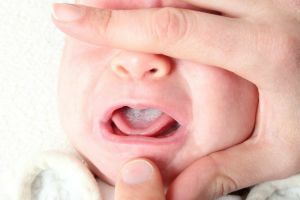 The birth of a child brings not only joyous chores to the house. Parents are not left uneasy and doubt about the well-being of their beloved child. Especially it is typical for his first days and months of life.
The birth of a child brings not only joyous chores to the house. Parents are not left uneasy and doubt about the well-being of their beloved child. Especially it is typical for his first days and months of life.
The most common cause of anxiety in parents is the appearance of a white coating that covers the delicate pink mucous membranes of the oral cavity.
Usually it is found on the upper surface of the tongue. But a white coating can also cover the cheeks, palate, gums, lips or immediately all the mucous in the mouth of the baby. Often this symptom appears in the maternity hospital.
Contents of
- When to not sound an alarm
- About reasons seriously
- Symptoms of thrush in young children
- Specification of diagnosis
- Treatment features and symptomatology
- Possible complications and preventive measures
- Adults also need to be on the alert
When not to sound an alarm
It's important to know thatwhite tongue and other mucous membranes are not always a sign of illness. 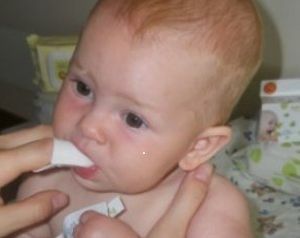
It is worth to inspect the mouth of the baby before and after feeding. If a minor raid appeared after feeding and only in the language, do not worry. It disappears on its own or after drinking water. These are traces of feeding breast milk, a mixture. From regurgitation in the process of feeding or after it, a small amount of cheesy plaque may also appear. This milk, which began to be digested in the stomach.
There is no change in the behavior of the child. He eats well and sleeps, his chair is ordinary. Remains of white tracks can be carefully removed with a sterile napkin or bandage soaked in boiled water.
Such manifestations in the first year of life are considered normal. Attentive parents notice them at the most part of babies.
But much more often all is not so rosy, and the white plaque in the mouth of a newborn baby is a symptom of candidiasis. The disease is also called candidal stomatitis, oral candidiasis, thrush. In this case, the plaque is not removed, there are other signs of the disease.
About the reasons seriously
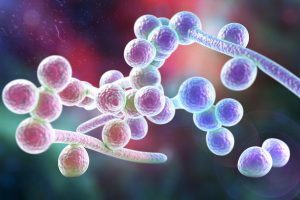
Candida mushrooms under the microscope
The emergence of pathology yeast-like fungi of the genus Candida. They are part of the microflora of the body, contribute to its normal functioning and are conditionally pathogenic. If there are certain causes, mushrooms multiply rapidly, become pathogenic.
The immune system of the baby is very weak, its formation and development is not complete. Under the influence of pathogenic fungi, the disease develops. The development of thrush in the oral cavity is facilitated by the following factors:
- prematurity of the child;
- predisposition to allergic reactions;
- disturbance of metabolic processes;
- vitamin deficiency;
- inflammatory diseases in the oral cavity;
- infringement of intestinal microflora;
- dysbacteriosis from taking antibiotics;
- diabetes;
- decreased immune forces by various diseases;
- stress;
- trauma to the oral mucosa;
- use of low-quality baby food, which contains an increased amount of sugar;
- violation of hygiene standards and childcare rules.
Infection is also possible during labor. The source of infection is the mother whose genital organs are affected by candidiasis.
Contact with a sick person can cause disease. Non-sterile bottles, nipples, pacifiers, toys, dirty hands of those who care for the child - the source of infection with fungi.
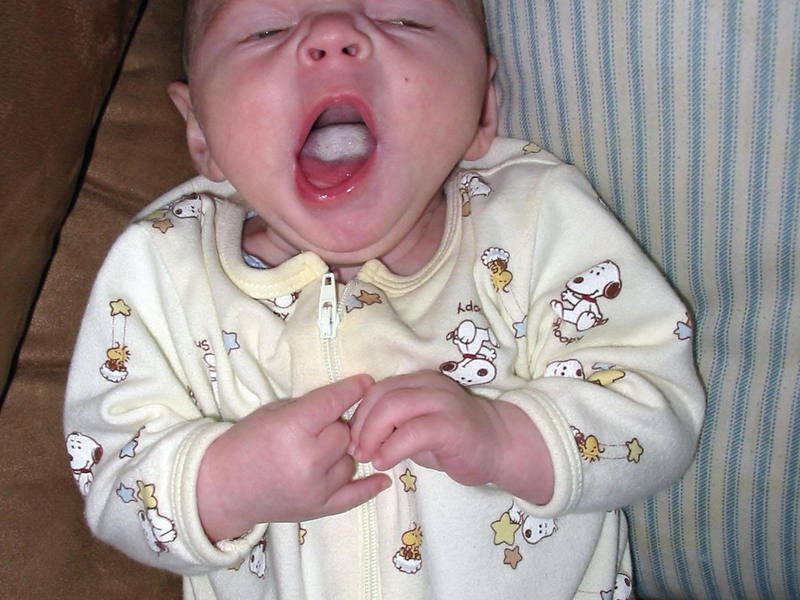
Symptoms of thrush in young children
The candidiasis of stomatitis in babies can be determined by such manifestations:
- the main symptom is the white curdled plaque in the mouth( in the sky, tongue, mucous), which can have shades of yellow and beige;
- restlessness, tearfulness;
- decreased appetite, refusal to eat;
- a sour smell from the mouth;
- soreness of lesions;
- plaque is removed after application of efforts;
- mucous, inflamed, red.
With severe development of oral candidiasis, all mucous mouths are affected in the infant, the pharynx is involved in the pathological process.
On mucous membranes, erosions and cracks form, they bleed. The temperature may rise. The child becomes sluggish.
Refinement of the diagnosis of
White plaque in the mouth can also be a symptom of some internal diseases, the presence of intestinal parasites. At the same time, characteristic signs appear, the color of the plaque changes. The child's doctor should know about this.
It takes into account external symptoms of candidiasis, but to confirm the diagnosis conducts laboratory diagnostics: 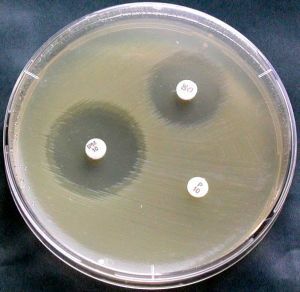
- a clinical blood test reveals the presence of an inflammatory process;
- bacteriological seeding of the material with mucous, indicate the appearance of fungi;
- antibiotic image will determine the sensitivity of the detected infection to antimycotic drugs.
To determine the internal problems that cause thrush, the doctor can prescribe a coprogram( general stool analysis) that will help diagnose diseases of the digestive tract, dysbacteriosis, helminths, lactase deficiency( lack of lactose for milk processing in the child's body).
A blood test for Helicobacter pylori reveals bacteria that also provoke the development of candidiasis.
Features of treatment and withdrawal of symptoms
Treatment of thrush in the mouth in a newborn child is most often at home, in severe cases - in a hospital. It is carried out strictly according to the doctor's prescription.
At the initial stages of the disease, a normal soda solution helps. To do this, a teaspoon of baking soda is dissolved in a glass of cooled boiled water. Sterile swab dipped in a prepared solution, treated the affected parts of the mucosa every 3 hours. Carry out carefully, without effort.
This solution is also recommended to treat objects and toys with which the child touches, the mother's breast before and after feeding. You can use a weak solution of potassium permanganate or alternate with a soda solution.
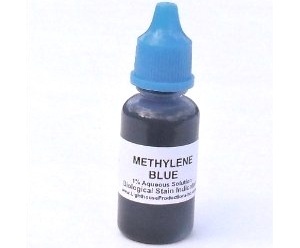 After that, the infection is smeared with bactericidal methylene blue.
After that, the infection is smeared with bactericidal methylene blue.
A specialist can prescribe rubbing mouth mucus with a solution of vitamin B 12( in ampoules).
The anti-inflammatory properties of honey are also used to treat candidiasis. It is applied to the treated surface with a sterile stick or with a dressing material( tampon, bandage, napkin).In mild cases, such treatment for a few days leads to recovery.
For severe disease, prescribe drugs with antifungal action. It can be Nystatin ointment, cream, spray or Kanestena solution, Clotrimazole.
The initiated cases are treated with antimycotic drugs with pronounced action( Diflazole, Fluconazole, Fungizone).Apply vitamin complexes for children.
Preterm infants are very difficult to tolerate thrush, their treatment is given special attention.
Possible complications and preventive measures
The disease can go on into a chronic form, spread to internal organs and cause serious complications:
- respiratory diseases;
- dehydration of the body;
- disorders in the work of the digestive tract, dysbiosis;
- development of sepsis due to the penetration of bacterial infection into the cracks, erosion in the lesions.
Any disease infants suffer difficult. Therefore, it is important to pay attention to prevention. If a pregnant woman suffers from genital thrush, she must cure her before the birth of the child, so as not to infect him.
In order to prevent the occurrence of plaque in the oral cavity of the baby, as well as other concomitant symptoms, it is necessary to perform simple activities:
- must comply with the rules of child care;
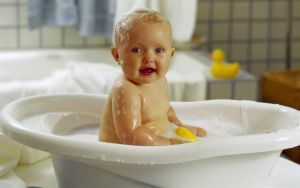
- daily bathe and perform oral hygiene in the baby;
- breast-feed the baby, since only the mother's milk will provide strong immunity, which protects from infection;
- everyone who is in contact with the baby should comply with personal hygiene standards;
- bottle, teat, dummy and toys, which the child can pull into the mouth, must be sterilized;
- use for children individual dishes;
- to maintain the purity of toys and objects with which the baby is in contact;
- does not kiss the baby on the lips to avoid infection through saliva.
Before each touch to the baby, his things and dishes, you should wash your hands with soap.
Adults also need to be on guard
An adult can also have a white plaque in his mouth. Its cause is the excessive use of products containing a large number of carbohydrates.
Milk swelling also provokes some diets, insufficient water intake. Poor hygiene of the oral cavity, smoking, alcoholism contribute to this.
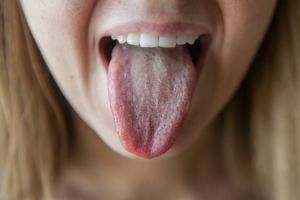 Balanced nutrition and drink, thorough and proper brushing of teeth, use of a special brush for cleaning the tongue, getting rid of bad habits will prevent not only dental diseases, but everything in general.
Balanced nutrition and drink, thorough and proper brushing of teeth, use of a special brush for cleaning the tongue, getting rid of bad habits will prevent not only dental diseases, but everything in general.
There is also plaque in the mouth in adults from thrush and internal diseases. Candidiasis is manifested due to a decrease in immunity, hormonal changes and as a complication of infectious and other diseases. Their list is much larger than that of children. Add to them the pathology of the language.
Symptoms are the same as in infants, but adults can tell about their feelings. To establish an accurate diagnosis to laboratory methods of research, if necessary, add ultrasound, fibrogastroscopy. Treatment is similar.
Internal diseases are treated by specialized specialists in the field. After recovery, the raid disappears.
To get rid of white plaque in the oral cavity of a child and an adult is not difficult, the main thing is to take the necessary measures in time. But it is better to prevent the problem than to fight it.
